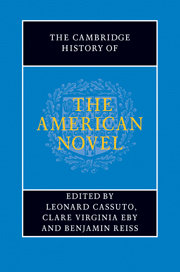Book contents
- Frontmatter
- General Introduction
- PART ONE INVENTING THE AMERICAN NOVEL
- PART TWO REALISM, PROTEST, ACCOMMODATION
- PART THREE MODERNISM AND BEYOND
- PART FOUR CONTEMPORARY FORMATIONS
- Introduction: contemporary formations
- 58 Postmodern novels
- 59 The nonfiction novel
- 60 Disability and the American novel
- 61 Model minorities and the minority model – the neoliberal novel
- 62 The American borderlands novel
- 63 The rise of the Asian American novel
- 64 Toni Morrison and the post-civil rights African American novel
- 65 Hemispheric American novels
- 66 The worlding of the American novel
- 67 The Native American Tradition
- 68 Contemporary ecofiction
- 69 Graphic novels
- 70 Twentieth- and twenty-first-century literary communities
- 71 A history of the future of narrative
- A selected bibliography
- Index
58 - Postmodern novels
from PART FOUR - CONTEMPORARY FORMATIONS
Published online by Cambridge University Press: 28 July 2011
- Frontmatter
- General Introduction
- PART ONE INVENTING THE AMERICAN NOVEL
- PART TWO REALISM, PROTEST, ACCOMMODATION
- PART THREE MODERNISM AND BEYOND
- PART FOUR CONTEMPORARY FORMATIONS
- Introduction: contemporary formations
- 58 Postmodern novels
- 59 The nonfiction novel
- 60 Disability and the American novel
- 61 Model minorities and the minority model – the neoliberal novel
- 62 The American borderlands novel
- 63 The rise of the Asian American novel
- 64 Toni Morrison and the post-civil rights African American novel
- 65 Hemispheric American novels
- 66 The worlding of the American novel
- 67 The Native American Tradition
- 68 Contemporary ecofiction
- 69 Graphic novels
- 70 Twentieth- and twenty-first-century literary communities
- 71 A history of the future of narrative
- A selected bibliography
- Index
Summary
Anatomies of postmodernism
During the last quarter of the twentieth century, the concept of the “postmodern” was without question the most important organizing category for a wide spectrum of debates about contemporary society and culture. As a fulcrum of discussions that ranged from philosophy, language, and literature all the way to questions of the human body, identity, political subjecthood, social inequality, science, technology, and economic structures, its implications became necessarily diffuse. Postmodernism was maligned for having too many meanings by some and for having no meaning at all by others, ridiculed by some as the epitome of pointlessly arcane and convoluted academicism and by others as a synonym for hopeless intellectual befuddlement. If the concept proved to have considerable staying power in spite of such attacks, critiques, dismissals, and jokes, it is undoubtedly because it did provide a convenient shorthand for wide-ranging debates about the legacies of modernity. Questions such as whether the worldwide spread of capitalism implied the globalization of Western modernity or its obsolescence, whether Enlightenment ideas of individual identity and political subjectivity were necessary tools or conceptual obstacles in struggles for gender or race equality and colonial independence, and what role science and technology should play in a pluralist and cross-cultural context of competing theories and practices of knowledge were debated across a wide variety of political, cultural, and academic venues.
The “modern” implicit in such debates was often the philosophical, political, and cultural legacy of a modernity whose most important roots were perceived to lie in the eighteenth century, but a somewhat different notion of the modern informed parallel conversations about literature and the arts.
- Type
- Chapter
- Information
- The Cambridge History of the American Novel , pp. 964 - 985Publisher: Cambridge University PressPrint publication year: 2011



